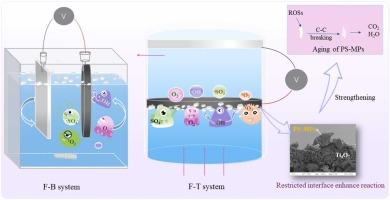Enhancing the aging of polystyrene microplastics through a flow-through electrochemical membrane system: Mechanism of confinement effect
IF 12.2
1区 环境科学与生态学
Q1 ENGINEERING, ENVIRONMENTAL
引用次数: 0
Abstract
Microplastics (MPs) are emerging pollutants in aquatic environments that pose serious health risks, and traditional wastewater treatments are ineffective at removing them. In this study, a flow-through electrochemical membrane (F-T) system was developed to simultaneously separate and age polystyrene microplastics (PS-MPs) in water. Under membrane pressure, PS-MPs were tightly pressed onto the surface of membrane electrode, forming a confinement space. The confinement effect overcomes the short lifetime of free radicals and accelerates the aging process of PS-MPs. This study identified the optimal conditions for aging PS-MPs in the F-T system, characterized the material properties before and after aging, and analyzed the degradation intermediates. After 8 h of treatment, the oxygen-to-carbon ratio (O/C) of the PS-MPs following the F-T system was 2.00 times greater than that following the traditional flow-by (F-B) system. In addition, the unit energy consumption (kW·h/g) for the aging of PS-MPs in the F-T system was 645.19 kW·h/g, which was 3.70 times lower than the F-B system. Free radicals, especially O2•- and •OH, played a major role in PS-MPs aging. Free radicals attack the main chain of PS-MPs, leading to subsequent chain breakage, hydrogen abstraction, and rearrangement reactions. After aging in the F-T system, the crystallinity, molecular weight, and zeta potential of the PS-MPs significantly decreased. In addition, carbon-centered environmental persistent free radicals formed on the surface of the PS-MPs. This study presents an energy-efficient method for the remediation of MPs in water and suggests that the aging efficiency can be increased through confinement.

求助全文
约1分钟内获得全文
求助全文
来源期刊

Journal of Hazardous Materials
工程技术-工程:环境
CiteScore
25.40
自引率
5.90%
发文量
3059
审稿时长
58 days
期刊介绍:
The Journal of Hazardous Materials serves as a global platform for promoting cutting-edge research in the field of Environmental Science and Engineering. Our publication features a wide range of articles, including full-length research papers, review articles, and perspectives, with the aim of enhancing our understanding of the dangers and risks associated with various materials concerning public health and the environment. It is important to note that the term "environmental contaminants" refers specifically to substances that pose hazardous effects through contamination, while excluding those that do not have such impacts on the environment or human health. Moreover, we emphasize the distinction between wastes and hazardous materials in order to provide further clarity on the scope of the journal. We have a keen interest in exploring specific compounds and microbial agents that have adverse effects on the environment.
 求助内容:
求助内容: 应助结果提醒方式:
应助结果提醒方式:


